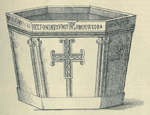| His Eminence Juraj Haulík Váralyai | |
|---|---|
| Cardinal. Archbishop of Zagreb | |
 | |
| Church | Roman Catholic |
| Archdiocese | Zagreb |
| Appointed | 11 December 1852 |
| In office | 1852–1869 |
| Predecessor | Aleksandar Alagović |
| Successor | Josip Mihalović |
| Other post(s) | Cardinal-Priest of Santi Quirico e Giulitta |
| Orders | |
| Ordination | 18 April 1811 |
| Consecration | 10 December 1837 by Lodovico Altieri |
| Created cardinal | 16 June 1856 by Pius IX |
| Rank | Cardinal-Priest |
| Personal details | |
| Born | (1788-04-20)20 April 1788 Trnava, Kingdom of Hungary, Habsburg monarchy |
| Died | 11 May 1869(1869-05-11) (aged 81) Zagreb, Kingdom of Croatia-Slavonia, Austria-Hungary |
| Nationality | Slovak |
| Coat of arms |  |
Juraj Haulik de Váralya (Slovak: Juraj Haulík Váralyai, Hungarian: Haulík Váralyai György; 20 April 1788 – 11 May 1869) was a Croatian cardinal in the Roman Catholic Church of Slovak ethnicity and the first archbishop of Zagreb. He was also acting ban of Croatia for two separate terms.
Life

He studied theology and philosophy in Trnava, Esztergom and Vienna. After the death of bishop Aleksandar Alagović [hr] in 1837, Haulik was proclaimed bishop. In 1840 he began his first term as acting ban of Croatia after the death of ban Franjo Vlašić. He is credited for introducing the Croatian language into schools and workplaces, as well as forming the Matica hrvatska in 1842. He helped the organization of Maksimir park in Zagreb.
He was succeeded as ban by the Hungarian Franz Haller. Haller was brought in to carry on Magyarization in Croatia, which included the banning of the then Croatian banner name: Illyrians. A protest by the Croatian People's Party in 1845 was put out violently by Haller, leaving thirteen protestors dead, and ending his time as ban. Haulik was again called upon to take up the post.
During this term, the Croatian language was made official in the Kingdom of Croatia-Slavonia in 1847. In 1848, in the midst of revolutions in the Austro-Hungarian Empire, military man Josip Jelačić was proclaimed ban, terminating union with Hungary and advocating for Croatian autonomy.
Some further autonomy did materialize for Croatia in the following years, as Haulik was proclaimed the first archbishop and metropolitan of Zagreb in 1852. With this, the Catholic Church in Croatia became independent from Hungary. In 1856 he was also named Cardinal. He carried on in these posts until his death in 1869.
While he was an ethnic Slovak, he said of his background: I was born a Slovak, but I will die a Croat. In 1999, Croatia and Slovakia put out a joint-issue stamp featuring Haulik.
References
- ^ "Rođen Juraj Haulik". vijesti.hrt.hr. Croatian Radiotelevision. 20 April 2015. Retrieved 8 February 2017.
- ^ "Haulik, Juraj de Várallya". enciklopedija.hr.
- Tomorad, Mladen (2019). Egypt in Croatia: Croatian Fascination with Ancient Egypt from Antiquity to Modern Times. Archaeopress Publishing Ltd. pp. 249–250. ISBN 9781789693409.
- Lipovac, Marijan (9 September 2019). "Juraj Haulik, Prvi Zagrebački nadbiskup i kardinal". nacionalnemanjine.hr.
- Velikonja, Mitja (2003). Religious Separation and Political Intolerance in Bosnia-Herzegovina. Texas A&M University. p. 113. ISBN 9781603447249.
- "Juraj Haulik - borac za hrvatska prava i jezik". Vjesnik (in Croatian). 15 June 1999. Archived from the original on 21 September 1999.
- "Cardinal Juraj Haulik - Archbishop of Zagreb". Croatian Post. Archived from the original on 6 March 2014. Retrieved 5 January 2013.
| Catholic Church titles | ||
|---|---|---|
| Preceded byAleksandar Alagović | Archbishop of Zagreb 1837–1869 |
Succeeded byJosip Mihalović |
| Preceded byFranjo Vlašić | Ban of Croatia 1840–1842 |
Succeeded byFranz Haller |
| Preceded byFranz Haller | Ban of Croatia 1845–1848 |
Succeeded byJosip Jelačić |
| Bans (viceroys) of Croatia | |
|---|---|
| Kingdom of Croatia | |
| Kingdom of Croatia-Slavonia |
|
| Acting bans indicated in italics. | |
| Croatian cardinals | ||
|---|---|---|
| 15th century |
|  |
| 16th century | ||
| 19th century | ||
| 20th century | ||
| 21st century | ||
